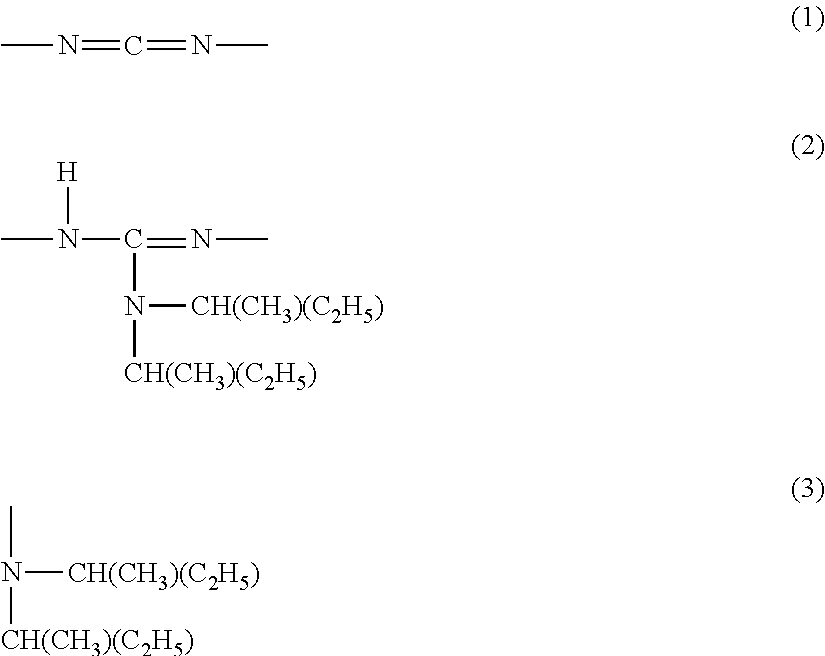Modified polycarbodiimide compound, curing agent, and thermosetting resin composition
a technology of curing agent and thermosetting resin, which is applied in the direction of coatings, polyurea/polyurethane coatings, etc., can solve the problems of low solubility and difficult storag
- Summary
- Abstract
- Description
- Claims
- Application Information
AI Technical Summary
Benefits of technology
Problems solved by technology
Method used
Image
Examples
synthesis example 1
[0038]A reaction vessel equipped with a reflux tube and a stirrer was charged with 100 parts by mass of tolylene diisocyanate (composition: 80% of 2,4-tolylene diisocyanate and 20% of 2,6-tolylene diisocyanate), 71.8 parts by mass of a polyalkylene carbonate diol (produced by Asahi Kasei Chemicals Corporation, DURANOL T-5651, molecular weight: 1000), 17.1 parts by mass of phenyl isocyanate, 245 parts by mass of toluene (boiling point: 110.6° C.), and 1.0 part by mass of a carbodiimidation catalyst (3-methyl-1-phenyl-2-phospholene-1-oxide), and the resultant was stirred under a nitrogen stream at 100° C. for 3 hours. It was confirmed from the results of measurement of infrared (IR) absorption spectrum that an absorption peak attributed to an isocyanate group at a wavelength of about 2270 cm−1 almost disappeared and that an absorption peak attributed to a carbodiimide group at a wavelength of about 2150 cm−1 was observed, and a polycarbodiimide compound of Synthesis Example 1 was obta...
synthesis example 2
[0039]A reaction vessel equipped with a reflux tube and a stirrer was charged with 100 parts by mass of tolylene diisocyanate (composition: 80% of 2,4-tolylene diisocyanate and 20% of 2,6-tolylene diisocyanate), 71.8 parts by mass of a polyalkylene carbonate diol (produced by Asahi Kasei Chemicals Corporation, DURANOL T-5651, molecular weight: 1000), 17.1 parts by mass of phenyl isocyanate, 245 parts by mass of tetrahydrofuran (THF, boiling point: 66° C.), and 1.0 part by mass of a carbodiimidation catalyst (3-methyl-1-phenyl-2-phospholene-1-oxide), and the resultant was stirred under a nitrogen stream with a solvent reflux for 6 hours. It was confirmed from the results of measurement of infrared (IR) absorption spectrum that an absorption peak attributed to an isocyanate group at a wavelength of about 2270 cm−1 almost disappeared and that an absorption peak attributed to a carbodiimide group at a wavelength of about 2150 cm−1 was observed, and a polycarbodiimide compound of Synthes...
synthesis example 3
[0040]A reaction vessel equipped with a reflux tube and a stirrer was charged with 100 parts by mass of tolylene diisocyanate (composition: 80% of 2,4-tolylene diisocyanate and 20% of 2,6-tolylene diisocyanate), 71.8 parts by mass of a polyalkylene carbonate diol (produced by Asahi Kasei Chemicals Corporation, DURANOL T-5651, molecular weight: 1000), 17.1 parts by mass of phenyl isocyanate, 245 parts by mass of methyl ethyl ketone (MEK, boiling point: 79.5° C.), and 1.0 part by mass of a carbodiimidation catalyst (3-methyl-1-phenyl-2-phospholene-1-oxide), and the resultant was stirred under a nitrogen stream with a solvent reflux for 5 hours. It was confirmed from the results of measurement of infrared (IR) absorption spectrum that an absorption peak attributed to an isocyanate group at a wavelength of about 2270 cm−1 almost disappeared and that an absorption peak attributed to a carbodiimide group at a wavelength of about 2150 cm−1 was observed, and a polycarbodiimide compound of S...
PUM
| Property | Measurement | Unit |
|---|---|---|
| boiling point | aaaaa | aaaaa |
| temperature | aaaaa | aaaaa |
| temperature | aaaaa | aaaaa |
Abstract
Description
Claims
Application Information
 Login to View More
Login to View More - R&D
- Intellectual Property
- Life Sciences
- Materials
- Tech Scout
- Unparalleled Data Quality
- Higher Quality Content
- 60% Fewer Hallucinations
Browse by: Latest US Patents, China's latest patents, Technical Efficacy Thesaurus, Application Domain, Technology Topic, Popular Technical Reports.
© 2025 PatSnap. All rights reserved.Legal|Privacy policy|Modern Slavery Act Transparency Statement|Sitemap|About US| Contact US: help@patsnap.com

